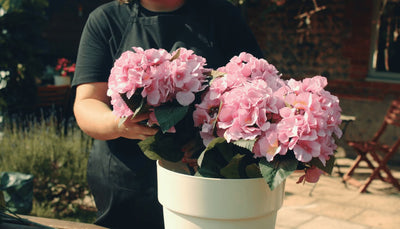
It’s beginning to look a lot like Christmas! Without a needle on the floor, our Christmas collection is here to bring instant, easy and unbelievably beautiful colour this festive season.

Hanging a decorative wreath on your door used to be a tradition reserved for only the festive season, however, this is no longer the case!
Seasonal wreaths have grown in popularity in recent years, with many UK households popping up an autumnal wreath as soon as the colder weather sweeps in. Sadly, the warmer seasons aren't getting this same, wreath-shaped appreciation!
When we think of summer, we think of barbecues, drinks in the garden and fun-filled family gatherings! So why not get your home summer-ready and create a welcoming entrance?
Follow along with our step-by-step guide to learn how to make an artificial summer wreath!
Real cut flowers simply do not last - there’s no use making a wreath, only for the flowers to fade away within a week!
Making a summer door wreath using artificial flowers ensures your style will stick around for far longer, meaning your wreath can be brought back out summer after summer.
Artificial flowers are also more durable than real ones. Summer showers and beaming sunlight will take its toll on your wreath, but a faux summer wreath can be treated to withstand even the harshest summer weather - unlike its real counterpart.
The other advantage of faux florals is that you can use out of season flowers to decorate your wreath. So even though they don’t bloom in July, you can add as many faux pansies you wish!
To learn more about the benefits of artificial plants, read our 'artificial vs real plants' blog.

With a plethora of summer wreath ideas to choose from, it can be easy to feel overwhelmed by choice, but when choosing your stems, it's important to remember that there’s no wrong way to do it!
If you want to get technical, there are several ways you can narrow down the style you want for your wreath - these are: by colour, theme or tone.

There are four types of colour schemes that you could follow to help you make a cohesive wreath design. These are monochromatic, complementary, analogous and triadic.
Monochromatic - involves just one colour for a simple, elegant style
Complementary – includes colours that are placed opposite each other on the colour wheel. Often results in a bold design.
Analogous – Uses three colours which are positioned next to each other on the colour wheel. The first is the more dominant colour, the second colour is next to the first on the colour wheel and the third colour can be a mixture of the first two colours e.g. Red, orange and white. This tends to result in a nice cohesive arrangement.
Triadic – Uses three colours which are evenly spaced on the colour wheel. This method tends to result in a rather vibrant style, which to some people can be fun and lively and to others a bit chaotic!
Creating a theme for your wreath is one of the easiest ways to create a cohesive design. In the UK, summer has two strong themes your faux wreath could embody: a countryside theme or a tropical theme.
An English countryside faux summer wreath is likely to feature an abundance of florals; ranging from delicate wildflower - such as cosmos - to flourishing roses. The English countryside theme encapsulates the gentle, yet magical side to summer, rich in large blooms and wildlife.
If you're looking to create something more tropical, your wreath should feature a mix of large-leaf foliage, such as our paradise leaf stem and bold, exotic faux flowers. This theme showcases the vibrancy of summer, bringing the wonders of the Caribbean sea breeze straight to your front door!

Another way to choose your flowers is to think about the effect you want your wreath to have. To create a friendly, cheerful and energetic wreath, the colours yellow and orange should be most prominent - for example.
If you’re not one for colour theory, feel free to have fun with your wreath, choose your favourite flowers and go for it! Try experimenting by pairing different flowers together and find your own unique combo.
For more insight into colour theory, check out our blog on the meaning and psychology of flower colours.
Let's get stuck into the craft!